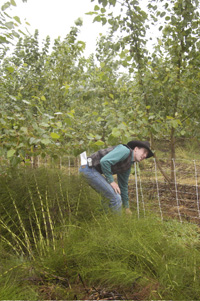Cooperation between hybrid-poplar tree farmers and sheep growers, can be beneficial for both parties according to results from a recent Western Sustainable Agriculture Research and Education (SARE) grant that GreenWood Resources received through the U.S. Department of Agriculture.
Richard Shuren, resource manager for GreenWood Resources in Clatskanie, was looking for a better way to control competing weed vegetation in the Columbia Tree Farm's 5,994 acres of hybrid poplars when he applied for the grant. To help with the study he went to Mac Stewart, a fourth generation Clatskanie farmer who was developing a program to raise commercial sheep and purebred Lincolns and North Country Cheviots on forage alone. To share the details and early results of their study, the two men hosted a field day August 24.
 |
'Sheep grazer Mac Stewart stands in an ungrazed portion of the poplar plantation at GreenWood Resources, showing the electric fence he used to confine sheep to the other side where they removed all weeds (Photo by J. Jackson) |
This article originally appeared in The Capital Press and is reprinted by permission - Editor.
"We established three one-acre plots in one, two and four-year old trees, and chose a mixture of forage rape and forage oats for a cover crop," Shuren said. We cultivated between the trees and sowed 50-lbs per acre of forage oats and 10-lbs per acre for forage rape plus 50 lbs per acre nitrogen (34-0-0). We mounted baffles near the spreader disk to prevent seed from moving into the tree rows and then rolled the plots with a flat roller. The oats germinated well, but even though the soil moisture was good and rainfall was recorded the next day, the forage rape was missing in all three plots.
"By the end of July, we were installing the electric fencing and water troughs complete with 300-gallon supply tanks and regulators. We brought in sheep that had been raised on native grasses and some clover and had never been exposed to any purchased feed on August 2."
Because they wanted the forage to sustain the sheep through a full month, the number of sheep placed in a specific plot was related to an assessment of available forage. "We used lambs that were four to four-and-one-half month old and weighed 65 to 70-pounds each." Stewart said. We placed seven head in the one-year- old stand, sixteen head in the two-year-old stand and twenty head in the four-year-old stand. But, when we assessed the situation two weeks later, we increased the stocking rate of the one-year stand by 57%, the two-year stand by 31% and decreased the four-year stand by 75%. Even though the forage oats did well in the four-year-old plot, it only took ten days for the sheep to seriously deplete the oats and knock down most of the other standing vegetation.
"Without rape and a limited amount of young grasses, the mature oats didn't provide the protein quality and quantity that is needed for exceptional growth however, considering the forage available the lambs did well," Stewart said. "When we do this next year, we will start grazing in the fall when the sheep can feed on native vegetation."
After taking a few more measurements to verify the benefit vs. negative impacts of grazing, Shuren will write a paper on the study and present it June 12-15, 2005, at the Ninth North American Agroforestry Conference in Rochester, Minnesota.
"We know from the study that we need to keep the sheep out of the one year-old trees because they damaged the trees more than we anticipated and to start grazing in the fall when the sheep can feed on native vegetation," Shuren said. "The good news is, we think we have shown that can provide good forage as well a as a small income stream to the farm by adding grazing to the overall program."
For more information, write Richard Shuren at GreenWood Resources, P.O. Box 1016, Clatskanie, Oregon 97016, or call 1-503-728-2171. Mac Stewart can be reached at Magruder Farms, 1-503-728-2945.
By Jan Jackson
Freelance Writer

